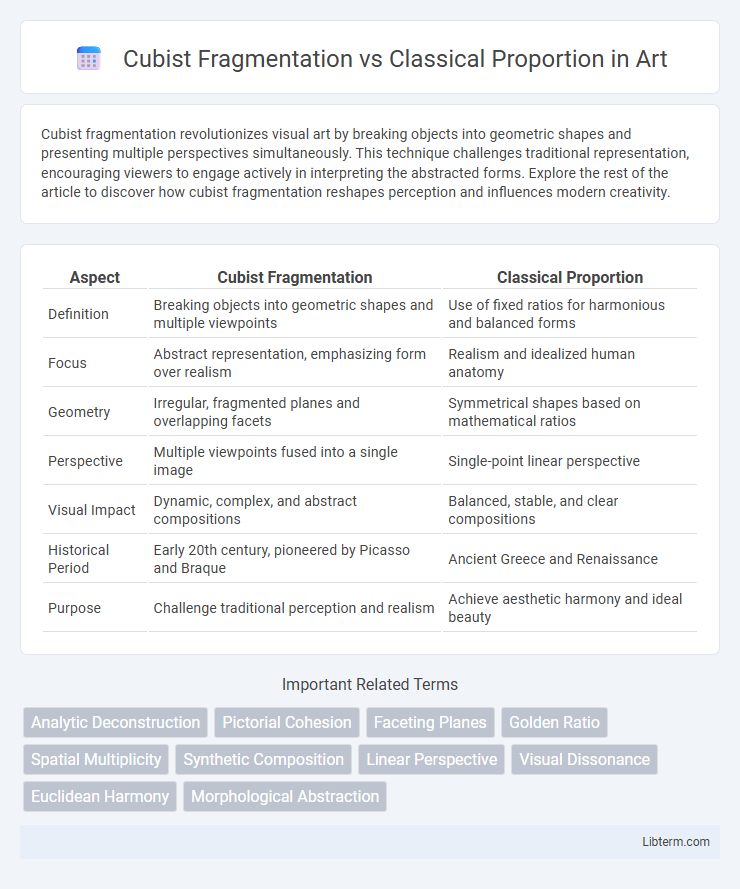Cubist fragmentation revolutionizes visual art by breaking objects into geometric shapes and presenting multiple perspectives simultaneously. This technique challenges traditional representation, encouraging viewers to engage actively in interpreting the abstracted forms. Explore the rest of the article to discover how cubist fragmentation reshapes perception and influences modern creativity.
Table of Comparison
| Aspect | Cubist Fragmentation | Classical Proportion |
|---|---|---|
| Definition | Breaking objects into geometric shapes and multiple viewpoints | Use of fixed ratios for harmonious and balanced forms |
| Focus | Abstract representation, emphasizing form over realism | Realism and idealized human anatomy |
| Geometry | Irregular, fragmented planes and overlapping facets | Symmetrical shapes based on mathematical ratios |
| Perspective | Multiple viewpoints fused into a single image | Single-point linear perspective |
| Visual Impact | Dynamic, complex, and abstract compositions | Balanced, stable, and clear compositions |
| Historical Period | Early 20th century, pioneered by Picasso and Braque | Ancient Greece and Renaissance |
| Purpose | Challenge traditional perception and realism | Achieve aesthetic harmony and ideal beauty |
Introduction to Artistic Paradigms
Cubist fragmentation challenges the classical proportion paradigm by deconstructing objects into geometric facets, emphasizing multiple viewpoints over singular, harmonious forms. While classical proportion adheres to mathematical ratios such as the Golden Mean to create balanced and realistic representations, cubism disrupts spatial coherence to evoke a more dynamic and conceptual perception of reality. This shift from traditional symmetry to fragmented abstraction marks a fundamental evolution in artistic paradigms during the early 20th century.
Defining Cubist Fragmentation
Cubist Fragmentation breaks down objects into geometric shapes and multiple viewpoints, challenging the traditional Classical Proportion that emphasizes harmonious and balanced measurements based on natural human anatomy. This artistic technique abandons linear perspective, presenting a deconstructed reality where form and space overlap. By fragmenting subjects into abstract facets, Cubism redefines visual representation through simultaneous perspectives and disrupted symmetry.
Understanding Classical Proportion
Classical proportion is based on mathematical harmony and balance, often exemplified by the Golden Ratio and the Vitruvian ideals, which create aesthetically pleasing and symmetrical compositions. It emphasizes clear, unified forms where each element relates logically to the whole, ensuring visual coherence and stability. Compared to Cubist fragmentation, which breaks objects into multiple perspectives and abstract planes, classical proportion maintains a consistent and natural representation of spatial relationships and human anatomy.
Historical Contexts and Influences
Cubist Fragmentation emerged in the early 20th century as a radical departure from Classical Proportion, challenging the Renaissance ideals of harmony and balance established by artists like Leonardo da Vinci. Influenced by the scientific advances in optics and the philosophy of simultaneity, Cubists such as Picasso and Braque deconstructed subjects into geometric facets to represent multiple viewpoints simultaneously. This shift reflected broader cultural changes, including the disillusionment after World War I and the rise of modernist thought prioritizing abstraction and subjective perception over traditional realism.
Techniques of Visual Representation
Cubist fragmentation disrupts traditional visual representation by breaking objects into geometric shapes and presenting multiple viewpoints simultaneously, challenging the classical proportion that relies on harmonious, mathematically precise measurements. Classical proportion emphasizes balanced, realistic spatial relationships and symmetry based on established ratios like the Golden Mean, ensuring lifelike accuracy and depth. Techniques in Cubism include overlapping planes and fractured perspectives that defy single-point perspective principles inherent in classical art.
Spatial Perception in Cubism and Classicism
Cubist fragmentation disrupts traditional spatial perception by breaking objects into geometric shapes and multiple viewpoints, challenging the viewer to reconstruct the image mentally. Classical proportion relies on harmonious ratios and perspective to create a coherent, unified spatial environment that reflects naturalistic depth. This contrast highlights Cubism's emphasis on abstract spatial relationships versus Classicism's focus on realistic spatial continuity and balance.
Impact on Viewer Interpretation
Cubist fragmentation disrupts classical proportion by breaking objects into multiple viewpoints, challenging the viewer to engage actively in reconstructing the subject's essence. Classical proportion relies on harmony and balance, fostering immediate recognition and emotional resonance through familiar spatial relationships. The impact on viewer interpretation is profound, as Cubism invites analytical perception and subjective meaning, while classical art offers clarity and universal comprehension.
Key Artists and Their Approaches
Cubist fragmentation, pioneered by artists like Pablo Picasso and Georges Braque, breaks subjects into geometric shapes and multiple viewpoints, emphasizing abstraction and deconstruction over traditional representation. In contrast, Classical proportion, upheld by Renaissance masters such as Leonardo da Vinci and Raphael, relies on mathematical ratios like the Golden Ratio to achieve balanced and harmonious compositions that reflect human anatomy and natural order. These differing approaches highlight Cubism's innovative challenge to visual perception versus Classical art's pursuit of idealized form and symmetry.
Legacy in Modern Art Movements
Cubist Fragmentation revolutionized artistic representation by breaking subjects into geometric planes, influencing modern art movements such as Futurism, Surrealism, and Abstract Expressionism. Classical Proportion emphasized harmony and balance rooted in ancient Greek and Renaissance ideals, shaping the foundations of academic art and neoclassical movements. The legacy of Cubism's fragmented approach fostered experimentation with perspective and form, while Classical Proportion continues to inform design principles and the pursuit of visual equilibrium in contemporary art.
Conclusion: Reconciling Fragmentation and Proportion
Cubist Fragmentation disrupts traditional Classical Proportion by breaking subjects into geometric facets that challenge unified perspective, yet both approaches share an underlying goal of representing reality through structure and balance. Reconciling fragmentation and proportion involves integrating Cubist multiplicity with Classical harmony, creating artworks that embody dynamic complexity while maintaining coherent spatial relationships. This synthesis fosters a deeper visual experience, merging analytical deconstruction with time-honored compositional principles.
Cubist Fragmentation Infographic

 libterm.com
libterm.com